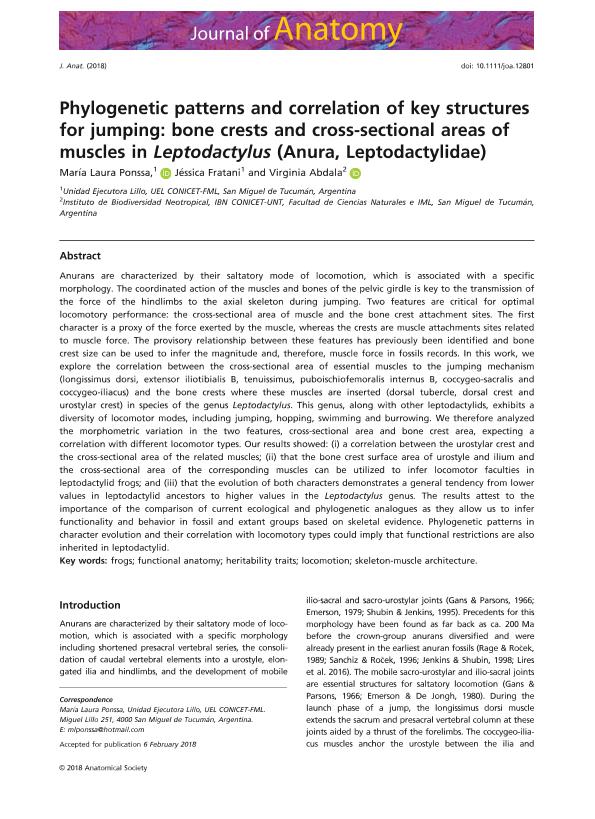Mostrar el registro sencillo del ítem
dc.contributor.author
Ponssa, María Laura

dc.contributor.author
Fratani Da Silva, Jéssica

dc.contributor.author
Abdala, Virginia Sara Luz

dc.date.available
2019-10-18T19:44:44Z
dc.date.issued
2018-02
dc.identifier.citation
Ponssa, María Laura; Fratani Da Silva, Jéssica; Abdala, Virginia Sara Luz; Phylogenetic patterns and correlation of key structures for jumping: Bone crests and cross-sectional areas of muscles in Leptodactylus (Anura, Leptodactylidae); Wiley Blackwell Publishing, Inc; Journal of Anatomy; 232; 5; 2-2018; 870-885
dc.identifier.issn
0021-8782
dc.identifier.uri
http://hdl.handle.net/11336/86480
dc.description.abstract
Anurans are characterized by their saltatory mode of locomotion, which is associated with a specific morphology. The coordinated action of the muscles and bones of the pelvic girdle is key to the transmission of the force of the hindlimbs to the axial skeleton during jumping. Two features are critical for optimal locomotory performance: the cross-sectional area of muscle and the bone crest attachment sites. The first character is a proxy of the force exerted by the muscle, whereas the crests are muscle attachments sites related to muscle force. The provisory relationship between these features has previously been identified and bone crest size can be used to infer the magnitude and, therefore, muscle force in fossils records. In this work, we explore the correlation between the cross-sectional area of essential muscles to the jumping mechanism (longissimus dorsi, extensor iliotibialis B, tenuissimus, puboischiofemoralis internus B, coccygeo-sacralis and coccygeo-iliacus) and the bone crests where these muscles are inserted (dorsal tubercle, dorsal crest and urostylar crest) in species of the genus Leptodactylus. This genus, along with other leptodactylids, exhibits a diversity of locomotor modes, including jumping, hopping, swimming and burrowing. We therefore analyzed the morphometric variation in the two features, cross-sectional area and bone crest area, expecting a correlation with different locomotor types. Our results showed: (i) a correlation between the urostylar crest and the cross-sectional area of the related muscles; (ii) that the bone crest surface area of urostyle and ilium and the cross-sectional area of the corresponding muscles can be utilized to infer locomotor faculties in leptodactylid frogs; and (iii) that the evolution of both characters demonstrates a general tendency from lower values in leptodactylid ancestors to higher values in the Leptodactylus genus. The results attest to the importance of the comparison of current ecological and phylogenetic analogues as they allow us to infer functionality and behavior in fossil and extant groups based on skeletal evidence. Phylogenetic patterns in character evolution and their correlation with locomotory types could imply that functional restrictions are also inherited in leptodactylid.
dc.format
application/pdf
dc.language.iso
eng
dc.publisher
Wiley Blackwell Publishing, Inc

dc.rights
info:eu-repo/semantics/openAccess
dc.rights
Atribución-NoComercial-CompartirIgual 2.5 Argentina (CC BY-NC-SA 2.5 AR)
dc.rights.uri
https://creativecommons.org/licenses/by-nc-sa/2.5/ar/
dc.subject
FROGS
dc.subject
FUNCTIONAL ANATOMY
dc.subject
HERITABILITY TRAITS
dc.subject
LOCOMOTION
dc.subject
SKELETON-MUSCLE ARCHITECTURE
dc.subject.classification
Zoología, Ornitología, Entomología, Etología

dc.subject.classification
Ciencias Biológicas

dc.subject.classification
CIENCIAS NATURALES Y EXACTAS

dc.title
Phylogenetic patterns and correlation of key structures for jumping: Bone crests and cross-sectional areas of muscles in Leptodactylus (Anura, Leptodactylidae)
dc.type
info:eu-repo/semantics/article
dc.type
info:ar-repo/semantics/artículo
dc.type
info:eu-repo/semantics/publishedVersion
dc.date.updated
2019-10-16T19:13:22Z
dc.journal.volume
232
dc.journal.number
5
dc.journal.pagination
870-885
dc.journal.pais
Reino Unido

dc.journal.ciudad
Londres
dc.description.fil
Fil: Ponssa, María Laura. Unidad Ejecutora Lillo Uel Conicet-fml San Miguel de Tucumán; Argentina
dc.description.fil
Fil: Fratani Da Silva, Jéssica. Consejo Nacional de Investigaciones Científicas y Técnicas. Centro Científico Tecnológico - Tucumán. Unidad Ejecutora Lillo; Argentina
dc.description.fil
Fil: Abdala, Virginia Sara Luz. Consejo Nacional de Investigaciones Científicas y Técnicas. Centro Científico Tecnológico Conicet - Tucumán. Instituto de Biodiversidad Neotropical. Universidad Nacional de Tucumán. Facultad de Ciencias Naturales e Instituto Miguel Lillo. Instituto de Biodiversidad Neotropical. Instituto de Biodiversidad Neotropical; Argentina
dc.journal.title
Journal of Anatomy

dc.relation.alternativeid
info:eu-repo/semantics/altIdentifier/url/https://doi.wiley.https://onlinelibrary.wiley.com/doi/abs/10.1111/joa.12801com/10.1111/joa.12801
dc.relation.alternativeid
info:eu-repo/semantics/altIdentifier/doi/https://dx.doi.org/10.1111/joa.12801
Archivos asociados
